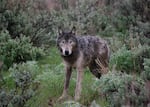
Oregon's first radio-collared wolf is pictured here just after their release on May 3, 2009.
Oregon Department of Fish and Wildlife/Flickr
The total population of gray wolves in Oregon increased again in 2020, continuing the species’ slow but steady rebound.
The Oregon Department of Fish and Wildlife announced Wednesday it counted a total of 173 wolves this past winter — up 9.5% from the previous year. That is likely an undercount of the entire wolf population in the state, but serves as a minimum estimate.
The minimum wolf population in Oregon has increased every year since the canids reestablished here in 2009.
“We are encouraged but also cautious at the same time because the population size is increasing slowly,” said Dr. Sristi Kamal, the senior Northwest representative for the conservation group Defenders of Wildlife. “The species is still very much in recovery.”
Oregon documented 22 wolf packs in 2020, the same number as the year prior, and those packs grew in population only slightly. The number of Oregon counties with wolves also stayed steady at 12.
The state lost two breeding pairs last year after poachers took out breeding males in the Ruckle Ridge and Cornucopia packs.
“Ultimately, for a species to recover, individuals have to be able to disperse, establish new packs in new territories, reproduce successfully, and reclaim what is historically and ecologically suitable habitat for wolves in the state,” Kamal said. “We sort of did not see that happen in 2020.”
Related: The fate of Oregon's gray wolves is now in the state's hands
ODFW’s latest annual wolf report comes under a cloud of concern for gray wolves’ future.
Former President Donald Trump’s administration removed gray wolves in the lower 48 states from the Endangered Species Act entirely in January, declaring the species recovered. Several lawsuits have challenged that decision, but the delisting currently remains in effect.
The report also arrives just weeks after five wolves were found dead in northeast Oregon — that’s a third of wolves added to the known population last year. The cause of those deaths remains unknown.
“That’s kind of the tricky part,” said Danielle Moser, the wildlife program coordinator for Oregon Wild. “Anything that’s now happened between January and April, we’re not necessarily capturing in this report.”
ODFW reported nine wolf fatalities in Oregon last year — many of them at the hands of humans.
Three Oregon wolves were illegally poached in 2020.
A driver struck and killed one wolf with their car on Interstate 84, and a boater apparently hit a wolf swimming across the Snake River. A livestock producer shot and killed one wolf legally. Another livestock producer killed a wolf they claimed to have mistaken for a coyote.
“[Those deaths are] a really big problem,” Moser said. “And that often is associated with reduced protections for wolves … it sort of sends a signal to the public that this species is devalued.”
Two younger wolves died of apparent natural causes.
The majority of Oregon’s wolves remained concentrated in the northeastern part of the state. ODFW identified no new packs in Western Oregon, though the agency did count five more wolves there in 2020 than in the previous year.
ODFW also recorded two wolves moving into Idaho and even one into California, both positive signs.
“It’s important to see that habitat connectivity and that wolves are able to move,” said ODFW spokesperson Michelle Dennehy. “And we continue to see that, so that is good news.”
Related: Oregon wolves could be expanding their range into California
Livestock depredation events nearly doubled from 2019 to 2020, most of them attributed to the Rogue Pack in Southern Oregon. Dennehy said livestock producers along with state and federal partners implemented non-lethal measures, including 99 nights of hazing, to try to ward off the pack.
“We appreciate our partners and, obviously, we appreciate all the livestock producers and others who are helping them using non-lethal measures to try to coexist with wolves,” Dennehy said.
State data suggest no correlation between an increasing gray wolf population and livestock depredation.
“The misconception we have that increasing wolves would mean increased interaction with livestock or more conflict is simply not true,” said Kamal with Defenders of Wildlife.
No wolves were killed at the hands of the state in 2020.
